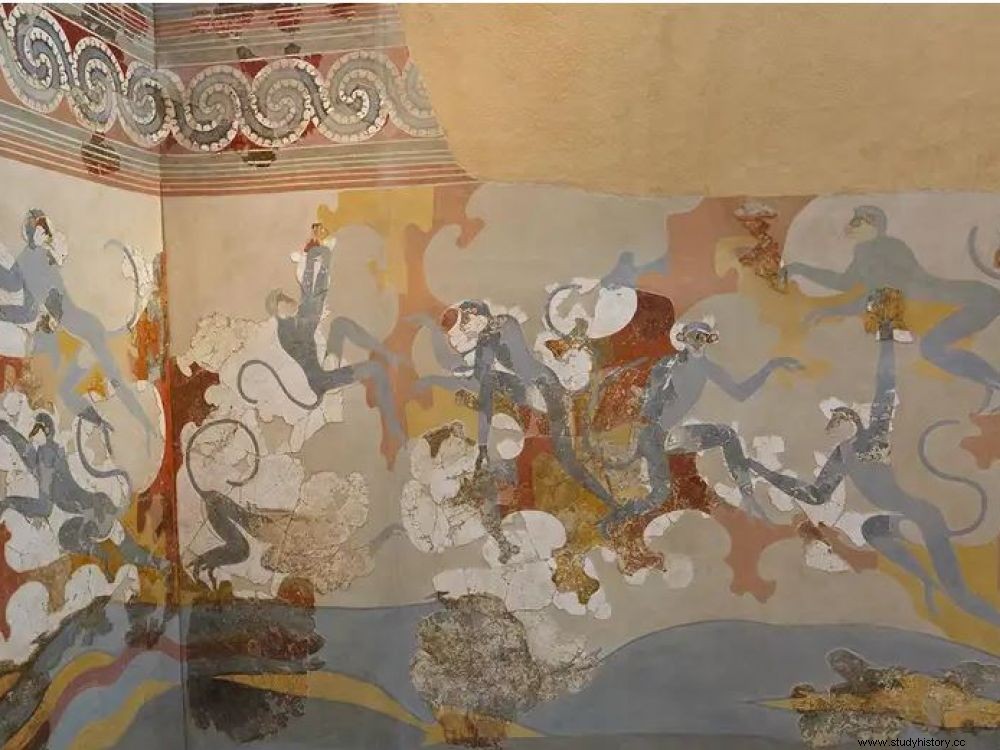Traditionally described as originating from Egypt or the Near East, monkeys adorning the walls of the famous site of Akrotiri, on the island of Santorini, in the Aegean Sea, could have had a much more distant origin...

Wall paintings of gray langur monkeys, on the site of Akrotiri, the ancient island of Thera (Santorini).
"Happy who, like Ulysses, had a nice trip…" , sang Joachim du Bellay in the 16th century, evoking the long journeys made in Antiquity by the ancient navigators of the Greek world. Long-term expeditions that could be even older and more distant than researchers previously thought for certain peoples of the Mediterranean, if we are to believe the new study of a mural fresco present on the island of Santorini ( ancient Thera), in the Aegean Sea. Blue-grey monkeys are depicted here, suggesting that artists from the Minoan civilization, which developed in the Bronze Age (about 2700–1200 BC) on the islands of Santorini, Crete and a much of the Aegean Sea, could have reached... South Asia! The mural fresco concerned decorates the walls of a building of the famous site of Akrotiri and dates from this civilization which was destroyed by a volcanic eruption around 1,600 BC.

Wall frescoes from the site of Akrotiri (Bronze Age), Santorini. © Leemage / AFP
The Indus Valley
The animals depicted had been described as baboons or even Barbary macaques (Macaca sylvanus ) - also called magots - originating in particular from Egypt.
"Happy who, like Ulysses, had a nice trip…" , sang Joachim du Bellay at 16 e century, evoking the long journeys made in antiquity by the ancient navigators of the Greek world. Long-term expeditions that could be even older and more distant than researchers previously thought for certain peoples of the Mediterranean, if we are to believe the new study of a mural fresco present on the island of Santorini ( ancient Thera), in the Aegean Sea. Blue-grey monkeys are depicted here, suggesting that artists from the Minoan civilization, which developed in the Bronze Age (about 2700–1200 BC) on the islands of Santorini, Crete and a much of the Aegean Sea, could have reached... South Asia! The mural fresco concerned decorates the walls of a building of the famous site of Akrotiri and dates from this civilization which was destroyed by a volcanic eruption around 1,600 BC.

Wall frescoes from the site of Akrotiri (Bronze Age), Santorini. © Leemage / AFP
The Indus Valley
The animals depicted had been described as baboons or even Barbary macaques (Macaca sylvanus ) - also called magots - originating in particular from Egypt. But a closer examination allowed researchers from the University of Pennsylvania (Philadelphia, USA) and the Zoological Society of London (England) to identify another species of monkeys very recognizable because of their tail in " S":that of gray langurs (Semonopithecus ), usually found in Nepal and India!

Grey langurs photographed in southern India. © Patrice Correa / Biosphoto /AFP
In an article published in the journal Primates , this team, made up of primatologists, a taxonomic illustrator and an art historian archaeologist, would have succeeded in "identifying a new potential region at the origin of these representations of apes:the valley of the 'Indus" . This valley where another important civilization developed in the Bronze Age (read Sciences et Avenir number 853). Did Minoans or Cretans travel to this part of the world? Or were they in contact with people who went there? Researchers wonder. "The Aegean world and the Indus may have been connected via Mesopotamia, and langurs may have been imported into the royal menageries favored by the rulers of these regions in those times. From there they may have been sighted by Cretan travellers “, replied the signatories of the article to the magazine New Scientist. Thus the monkeys of Akrotiri, could well be the proof of contacts indicating that in the Bronze Age, exchanges between apparently distant and distant civilizations did indeed could take place.
